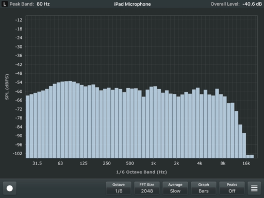Sub set-up prep: Part 2
Where exactly to do place the main speakers?
A extremely useful guide as a place to start is here
http://www.cardas.com/room_setup_rectangular_room.php
I found the distance to the side walls was spot on with his recommendation. As far as distance to the back wall, I played around a bit and when you have everything on sliders, it’s really easy and a one man job.
What you need to do is just play around until you get a pink noise response at the listening position that is reasonable smooth and looks like this using the Onyx Analyzer program above

This is going to take some work. Using the Cardas starting point as a reference, the first thing you will do is calculate the distance of the listening position based on the width of the speaker. (For Wilson Alexandrias, a reasonable starting point is to place them using the recommended “ideal” Wilson triangle ratio of 1.1-1.25.. For other speakers, trial and error is probably the best way to get there, but it can take some work!.Whether you prefer to be inside the ideal equilateral triangle (often called near-field or quasi near-field) or outside the triangle is strictly personal preference and is very much speaker/room/listener preference. I've heard great systems that run the gamut as far as the triangle set-up paradigm is concerned.
Don’t worry about getting it “perfect” until you get your low frequencies to look as smooth as the graph above. There SHOULD be a small gradual peak at around 60-80Hz as this mimics the famous B&K microphone curve I have talked about for years.
You are not looking for a flat frequency response here!! But what you want to do is place the speakers so you avoid large (10-20dB) peaks and valleys.
THAT is the key. If you can do this, chances are you are in good shape moving forward. Once you’ve gotten this far, its fairly easy to identify individual resonances with the Granite test CD.
Then, you can go back to the amroc site, put the cursor over the exact frequency that causes the resonance, and go to the “Room 3D” graph to see exactly where the room is pressurized so you know exactly where it might be helpful to put in a ASC tube traps or other resonance reduction devices. I wish someone would have shown me this years ago. I would have me saved tons of time doing trial and error room correction.
If all goes well, it should only take you about a month to get it right. (I’m serious). It took me a year to do this but I had to stumble through this the hard way and get educated first. If someone told me what I just told you, I could have done it in a month. (The Wilsons are the hardest speakers I’ve ever set up due to their exasperating demands for exact listening height which is highly listener dependent.). Finally, when you’ve done that, you can really work on fine-tuning the sub set-up. But believe me, setting up subs without doing this work first is a complete waste of time. Changing cable and PCs at this point honestly is a fool’s errand. Plenty of time for that down the road. You really need to get the fundamentals right first. No cable or cord is going to fix a 20dB peak or trough. Just like you can’t take out a cataract and get 20/20 vision if you have a 20/100 retina, the same is true here. I used that line with an ophthalmology buddy who understood what I meant immediately!)
For the subs, I do think that getting the cabinets or voice coils in the same plane is critical, especially if you’re not using dsp. From here on out, the best way to finalize position is to listen to one channel at time with material that is not overly complex. Simple recording of piano (left hand), acoustic bass, isolated kick drum, and of course, human voice will offer a lot to make these adjustments doable. Once you think you’ve got it, hopefully you’ll find that placing both subs similarly for both channels will give you great results.








